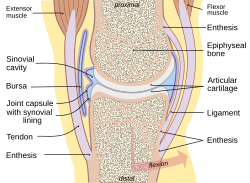Top Qs
Timeline
Chat
Perspective
Enthesitis
Inflammation where tendons and ligaments attach to bones From Wikipedia, the free encyclopedia
Remove ads
Enthesitis is inflammation of the entheses (singular: enthesis), the sites where tendons, ligaments and joint capsules attach to bones.[1][2]
This section needs additional citations for verification. (October 2019) |
It is a type of enthesopathy, meaning any pathologic condition of the entheses, with or without inflammation. There are some cases of isolated, primary enthesitis which are very poorly studied and understood. It is known to be associated with other autoimmune diseases, like spondyloarthropathies and psoriasis (thought to often precede psoriatic arthritis). A common autoimmune enthesitis is at the heel, where the Achilles tendon attaches to the calcaneus.
It is associated with HLA B27 arthropathies, such as ankylosing spondylitis, psoriatic arthritis, and reactive arthritis.[3][4]
Remove ads
Signs and symptoms
Early clinical manifestations are an aching sensation akin to "working out too much", and it gets better with activity. It is worse in the morning (after sleeping and not moving). The muscle insertion hurts very focally as it joins into the bone, but there is little to no pain at all with passive motion.
Symptoms include multiple points of tenderness at the heel, tibial tuberosity, iliac crest, and other tendon insertion sites.
Remove ads
Diagnosis

Remove ads
Management
- Non steroidal anti-inflammatory drugs (NSAIDs).[2]
- corticosteroid injections.[2]
- Disease-modifying anti-rheumatic drug (DMARD).
Related conditions
Anatomically close but separate conditions are:
- Apophysitis, inflammation of the bony attachment, generally associated with overuse among growing children.[5][6][7]
- Tendinopathy is a disorder of the tendon, and is associated with direct injury or repetitive activities.[8]
References
External links
Wikiwand - on
Seamless Wikipedia browsing. On steroids.
Remove ads

